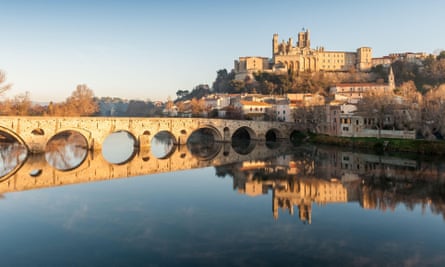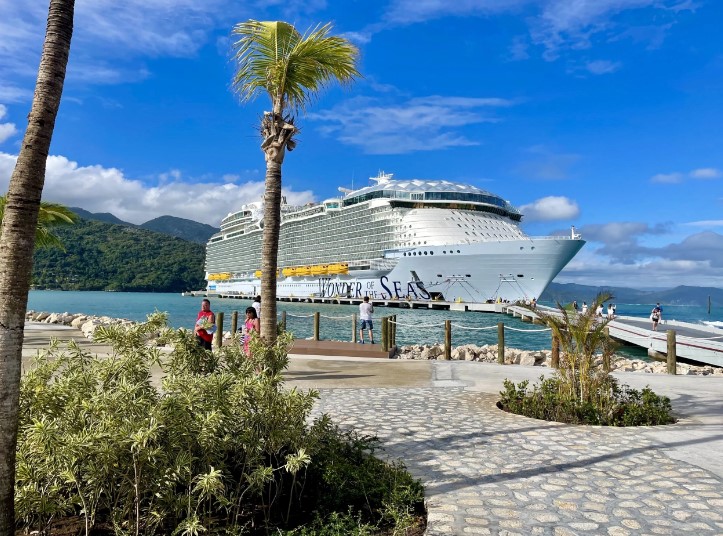Few pleasures compete with relaxing on a comfortable train and watching the landscape slip by beyond the window. Here are six of my favourite routes, ranging from under four to over nine hours, so easily completed in a day. Interrail passes are valid on all these journeys, although a small supplement (€1.50 to €4) is payable by passholders on the French, Polish and Spanish routes.
Cologne to Basel
Departs 10.53 from Cologne (daily)
Journey time 4h 43m (318 miles)
Fare Discount from €29.90, full €135
Buy Deutsche Bahn
Rail travellers heading south from the German Rhineland to the Alps are spoilt for choice. Most opt for high-speed trains on new-build lines that defy the warp and weft of the land. But it’s more interesting to take the traditional route south, following the classic Rhine gorge railway upstream from Koblenz.
Of the trains running south from Cologne (pictured above) which follow this line, my top choice is the mid-morning EC9 as this Swiss train to Basel and Zürich is the only one of the day to include a Swiss panorama carriage. It’s first-class only (upgrades from €10 on promo tickets) and includes an excellent but pricey Swiss restaurant car. Sit back and enjoy the ride as the train cruises up the Rhine, with views of the Black Forest and over the river into France’s Alsace region.
Zurich to Graz

Departs 08.40 from Zurich (daily)
Journey time 9hr 34min (451 miles)
Fare Discount from €33.10, full €111.50
Buy Austrian Railways
Pressed for my favourite north-south route through the Alps, I’d opt for the Bernina Railway from St Moritz in the Engadin region of Switzerland to Tirano in Italy. But for longer Alpine journeys, look for east-west routes; my top choice is the daily Transalpin train from Zurich to the Austrian city of Graz.
There’s a mix of Austrian and Swiss carriages: an Austrian restaurant car where the apple strudel is every bit as good as you might expect and a first-class Swiss panorama carriage, so it’s worth paying the premium for a first-class ticket (from €20 extra on promo fares). The journey traverses Liechtenstein and follows the Arlberg railway east into the Austrian Tyrol. Beyond Innsbruck, the route runs on via Zell-am-See and Selzthal to the Austrian province of Styria.
Dublin to Tralee

Departs 08.30 from Dublin Heuston (direct train Sundays only)
Journey time 3hr 52min (208 miles)
Fare Discount from €26.99, full €33.99
Buy Irish Rail
Dublin’s Heuston station, a handsome building in Corinthian style, is most inviting on a quiet Sunday morning. I pick up coffee and breakfast as there’s no catering on the 8.30am to County Kerry. It’s the only train of the week from Dublin giving a lunchtime arrival in Killarney and Tralee in Ireland’s south-west. The Dublin station is named after Sean Heuston, the Irish republican hero executed by the British in May 1916 at Kilmainham Gaol, which is just to the left as our train sets off from Heuston station.
The journey to Tralee goes through some glorious landscapes. The railway tracks south-west, passing the Galtee Mountains to reach the dairy farming country of the Golden Vale. Beyond Mallow, we follow Blackwater Valley west. On the approach to Killarney is one of Ireland’s grandest vistas, with Mangerton mountain grading west into MacGillycuddy’s Reeks. After stopping at Killarney, the train makes a final spring to the coast, where the Tralee Casement has the distinction of being Europe’s most westerly railway station. Why Casement? The station is named after Roger Casement, an Irish nationalist hanged at Pentonville Prison in London in 1916.
Béziers to Clermont-Ferrand

Departs 09.33 from Béziers (daily)
Journey time 6hr 28min (246 miles)
Fare Discount from €20, full €58.60
Buy SNCF Connect
The Intercité Aubrac from Béziers to Clermont-Ferrand offers, quite simply, the finest six-hour train ride in France. Even the best rail journeys in the French Alps don’t match the Ligne des Causses that runs north from Béziers.
Despite the Intercité tag, the Aubrac has the feel of a regional service, making more than a score of stops at country stations along the way. The line cuts through the hills to reach the Tarn valley, skirting many gorges on spectacular viaducts. This former mainline route is electrified throughout and is mainly single-track. It’s remarkable it has survived. If you are tempted, don’t wait too long – the future of the route is far from assured.
The IC Aubrac offers an excellent range of onward connections from Clermont – continue to Vichy, Nevers or even to Paris (giving an evening arrival in the French capital). This is a much better way of travelling from the Occitanie region to Paris than just hopping on the high-speed TGV.
Warsaw to Mockava

Leaves: 07.35 from Warsaw (daily)
Journey time 6hr 6min (228 miles)
Fare €20
Buy Lithuanian Railways
Mockava is a wee place of no more than 100 souls, just over the Polish border. There wasn’t a direct train from Warsaw to Lithuania for a decade, so the launch last month of a once-daily intercity from the Polish capital to Mockava came as a surprise. The train is called the Hańcza, after a river and lake in north-east Poland.
It is a journey through wistfully beautiful landscapes, passing villages and towns that reflect the cultural mosaic of the Polish-Lithuanian borderlands: old Jewish shtetls, wooden churches which can be Roman Catholic, Greek-Catholic or Orthodox, and Baltic Tatar communities with small surviving Muslim minorities.
The bleak subterranean platforms at Warsaw’s Central station are the starting point. Progress is leisurely, averaging 37mph and with some long stops along the way – a full 30 minutes at Białystok. Rumours of an onboard catering trolley are unfounded, so that extended stop at Białystok is a godsend. Mockava is the end of the line for the Polish train, but across the platform a modern Lithuanian train is waiting for the onward hop to Kaunas and Vilnius.
Madrid to Seville

Departs 10.55 from Madrid (daily)
Journey time 8hr 3min (403 miles)
Fare €50.70
Buy Renfe
The fastest Spanish high-speed trains dash nonstop between these two cities in just 2½ hours. But there’s a fine alternative for slow travellers. A daily Media Distancia (MD) train takes a deeply rural, very pretty route to Seville. This daily regional service slips out of the underground suburban platforms at Madrid Atocha and tracks west through the Extremadura region, affording good views of the Tajo and Guadiana valleys before cutting south through the Sierra Morena to reach Seville.
I rate the final three hours of the trip as one of the finest Iberian train rides. For an overnight stop, opt for the walled city of Cáceres – a fine place for casual wandering – before continuing to Seville the following afternoon.
Nicky Gardner is an author and co-editor of Hidden Europe magazine






More Stories
6 Reasons To Visit This Underrated European Destination This Summer
Weaker U.S. dollar making travel to Europe more costly
Business-class flights to Europe are as low as $2,494